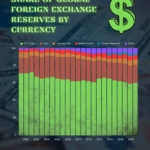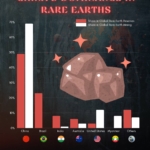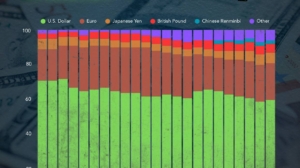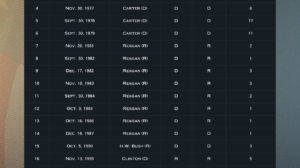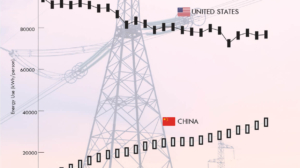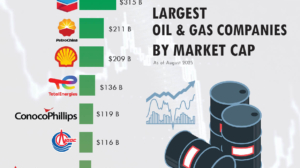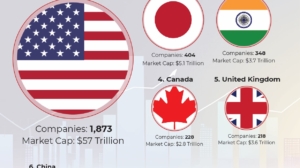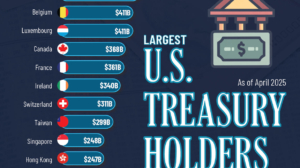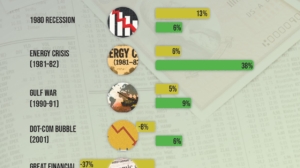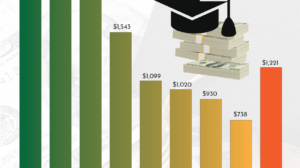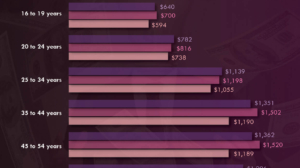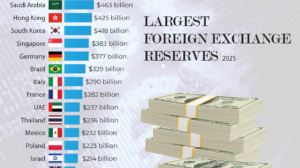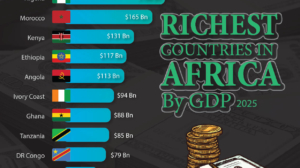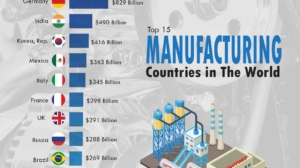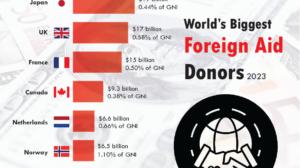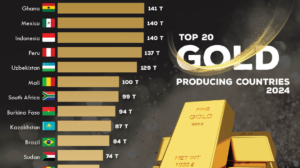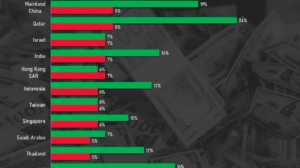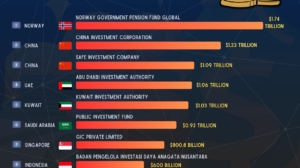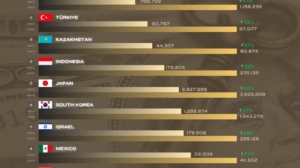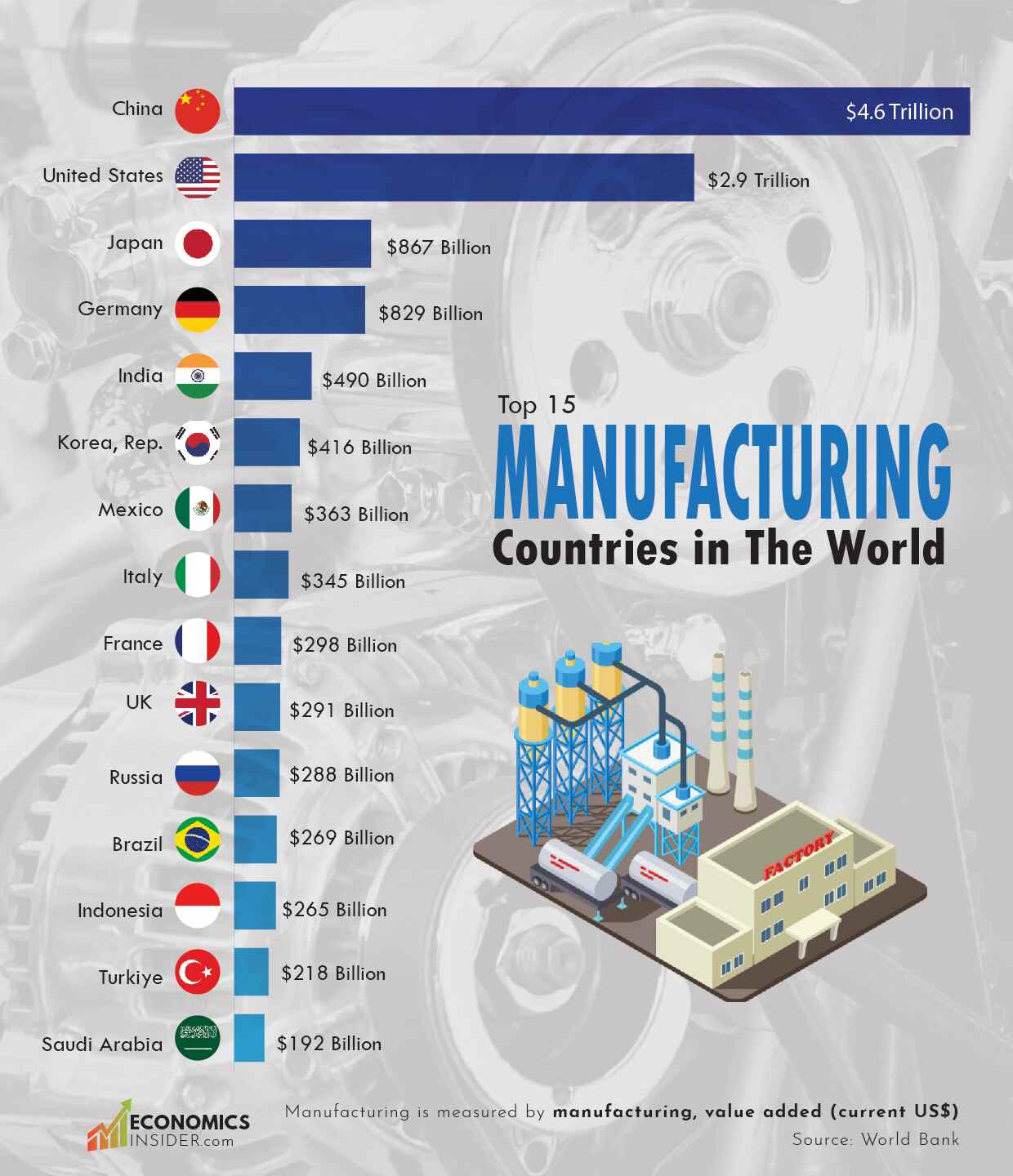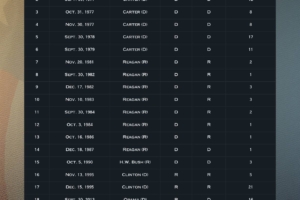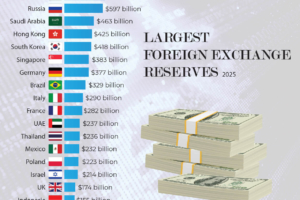Every country produces goods, but not many countries lead when it comes to size, value, and impact. When we talk about the top manufacturing countries in the world, China and the U.S. are always at the very front. These two countries produce goods worth trillions of dollars, and thus they are the leaders in nearly every manufacturing industry.
China is also referred to as the “factory of the world.” It manufactures everything from cellphones and machinery to clothing and cars. With a manufacturing output of $4.66 trillion, China leads the way. The United States, though smaller in volume at $2.91 trillion, has a high-value industry concentration in aerospace, defense, and advanced technologies.
Key Takeaways
- China and the United States lead global manufacturing with trillions in production.
- Asia is the industrial leader in terms of growth, with India and Indonesia climbing rapidly.
Global Manufacturing Overview
Asia unequivocally leads the way in industrial manufacturing with China, India, Korea, Japan, and Indonesia being among the top manufacturing countries in the world. Europe is equally a large industrial giant with Germany, Italy, France, and the United Kingdom.
The gap between the production of the top two — the U.S. and China — and the rest is massive. While China alone has a production of more than $4.6 trillion, Japan, the third-largest producer, comes in at less than $900 billion. And yet, all the countries in the top manufacturing countries in the world have significant roles to play. Some specialize in high technology, some in traditional industries such as textiles, foodstuffs, or chemicals. Together, they form the backbone of the world economy.
Top Manufacturing Countries in the World
Below is a table indicating the rank of the Top Manufacturing Countries in the World, according to the latest values.
| Rank | Country | Value |
|---|---|---|
| 1 | 🇨🇳 China | $4.66 Trillion |
| 2 | 🇺🇸 United States | $2.91 Trillion |
| 3 | 🇯🇵 Japan | $867.11 Billion |
| 4 | 🇩🇪 Germany | $829.96 Billion |
| 5 | 🇮🇳 India | $490.40 Billion |
| 6 | 🇰🇷 Korea, Rep. | $416.39 Billion |
| 7 | 🇲🇽 Mexico | $363.79 Billion |
| 8 | 🇮🇹 Italy | $345.29 Billion |
| 9 | 🇫🇷 France | $298.28 Billion |
| 10 | 🇬🇧 United Kingdom | $291.80 Billion |
| 11 | 🇷🇺 Russian Federation | $288.11 Billion |
| 12 | 🇧🇷 Brazil | $269.83 Billion |
| 13 | 🇮🇩 Indonesia | $265.07 Billion |
| 14 | 🇹🇷 Turkiye | $218.58 Billion |
| 15 | 🇸🇦 Saudi Arabia | $192.67 Billion |
🇨🇳 China
China’s industrial prowess can’t be matched. In 2025, its value-added manufacturing totaled around $4.66 trillion, accounting for almost 29% of world manufacturing output. China’s industrial production includes steel, petrochemicals, machinery, consumer electronics, textiles, autos, and others. Its “Made in China 2025” strategy focuses on industries such as robotics, AI, electric cars, and advanced materials.
China also invests heavily in automation. It adds more industrial robots annually than nearly any other nation. In March 2025, many industrial sub-sectors grew in China such as automobile manufacturing increased, electronics production rose, and general machinery saw gains.
China also faces challenges such as rising labor costs and demographic pressures that push it to move up the value chain. Also, tensions with trade partners, particularly the U.S., also impact China’s exports and trade.
🇺🇸 United States
With $2.91 trillion in manufacturing output, the U.S. ranks second. Its strength lies less about volume and more about high-value, high-technology products. The U.S. is the global leader in aerospace, defense, medical devices, semiconductors and advanced machinery production.
Government and private industry spend a lot on R&D, automation, and digital production. The connection between industry, startups, and universities keeps the U.S. as one of the top manufacturing countries in the world. Most U.S. manufacturing employment has gone offshore, but the nation aims to remain competitive with investments in robotics, AI, and supply chain technologies.
Manufacturing jobs have been shrinking ever since President Donald Trump announced new tariffs in April 2025. Since then, the sector has lost about 42,000 jobs, while job openings have dropped by 76,000 and actual hires by 18,000. In August 2025 alone, manufacturing lost another 12,000 jobs, bringing the total decline since April to 42,000.
🇯🇵 Japan
Japan’s production of approximately $867 billion ranks it third. The nation is renowned globally for autos, electronics, precision machinery, and robotics.
Japanese firms pioneered the concepts of lean manufacturing and ongoing improvement, referred to as Kaizen. These practices emphasize minimizing waste, improving efficiency in work, and increasing quality incrementally. Factories globally have imitated and implemented these concepts over time.
Japan is also a leading provider of critical materials, components, and parts that other nations require in order to produce their own goods. Nevertheless, its growth is threatened by an aging population and labor shortages.
🇩🇪 Germany
Germany generates approximately $829.96 billion in manufactured products, ranking it as Europe’s largest industrial center. Germany is particularly well-positioned in the manufacturing of automobiles, machinery, factory equipment, chemicals, and sophisticated industrial systems that are well regarded globally for their quality and reliability.
The concept of Industry 4.0 originated in Germany. It refers to operating intelligent factories with interlinked machines, data exchange, and the acceleration of production to become faster, smarter, and more efficient with the aid of technology.
People all over the world trust German manufacturing because it is reputable for being precise, reliable, and innovative. Nevertheless, Germany has challenges today.
🇮🇳 India
India’s manufacturing is valued at approximately $490.40 billion and ranks fifth globally. Its industries are increasing rapidly, making goods such as textiles, steel, chemicals, pharmaceuticals, and vehicles. The government is also operating a large initiative named ‘Make in India’ to attract businesses to invest, enhance infrastructure such as roads and power.
As compared to the rest of the top manufacturing countries in the world, India is attempting to introduce advanced systems such as Industry 4.0, with digital manufacturing and utilization of automation for making factories brighter and quicker. But India still has issues like poor infrastructure, complex regulations, and insufficient skilled laborers.
🇰🇷 South Korea
Manufacturing in South Korea amounts to approximately $416.39 billion. The nation is a leader worldwide in producing semiconductors, electronics, ships, and heavy machinery. Iconic businesses such as Samsung, SK Hynix, and Hyundai demonstrate how much South Korea emphasizes technology and innovations.
All this achievement is due to the nation’s significant research and development expenditure, its robust export emphasis, and its well-maintained supply chain.
🇲🇽 Mexico
Mexico’s manufacturing is valued at approximately $363.79 billion. It has one of its largest strengths in being proximate to the United States, which makes it easy for it to trade with through such pacts as NAFTA and USMCA. Mexico also enjoys cheaper labor, and that makes it attractive for international carmakers, electronics firms, and home appliance makers to have plants there to serve the North American market.
🇮🇹 Italy
Italy’s industry is valued at approximately $345.29 billion. The country is renowned for making high-end fashion, luxury items, automobiles, and accurately engineered machinery. Italian industry stands out in that it combines style and creativity with accurate engineering and technical ability.
But the majority of Italian factories and businesses are relatively old, and they must implement new digital technologies to compete. Meanwhile, lower-cost manufacturers from foreign countries generate strong competition, and this makes it increasingly difficult for traditional Italian industries to maintain their market share.
🇫🇷 France
French manufacturing is approximately $298.28 billion in value. The nation is robust in a number of areas, including aerospace, in which Airbus is a global leader, and defense systems, luxury products, chemicals, and advanced materials.
France invests a great amount in research and development, which enables it to produce high-quality products that are marketed worldwide.
🇬🇧 United Kingdom
The manufacturing of the United Kingdom is valued at around $291.80 billion. It is famously known for the production of high-precision engineering goods, pharmaceuticals and medications, aerospace components, and customized machinery.
One of the major strengths of the UK is the close interlink between its leading research universities and industry, which drives innovation and new technology. Since Brexit, it has had to adapt to new market conditions and trading rules.
🇷🇺 Russian Federation
Russia’s manufacturing is valued at approximately $288.11 billion. Most of its industry concentrates on heavy machinery, defense equipment, metals, chemicals, and products related to its vast energy resources.
Most of Russia’s manufacturing power is derived from utilizing the natural resources and serving its defense industry. Nevertheless, Russia has some serious challenges such as sanctions from abroad and geopolitical tensions that restrict trade and technology access.
🇧🇷 Brazil
Brazil’s industry is around $269.83 billion, the largest in Latin America. It is well-established in food processing, the production of cars, aircraft production with its corporation Embraer, and agricultural machines.
Brazil also has an extremely large domestic market, which provides stable demand for manufactured products. But there are issues that slow it down as well. Challenges such as corruption, complex bureaucracy, and inadequate infrastructure make it more difficult for businesses to expand.
🇮🇩 Indonesia
Indonesia’s manufacturing is valued at approximately $265.07 billion. Indonesia is expanding its sectors of textiles, electronics, footwear, and consumables. With its huge and youthful population and continued investment in infrastructure like roads, ports, and power, Indonesia has great prospects for taking more investment and playing an increasingly greater role among the top manufacturing countries in the world.
It still has numerous challenges to overcome, though. Productivity is low, the workforce requires more skills, and issues with power supply, logistics, and complex regulation slow down growth.
🇹🇷 Turkey
Turkey’s industry is valued at approximately $218.58 billion. Turkey is particularly good at making textiles, apparel, domestic household products, automotive components, and machinery. Another significant advantage of Turkey is its position, which straddles Europe and Asia, providing direct access to both markets for trade.
However, Turkey also has several serious issues. Its high inflation rate, frequent fluctuations in its exchange rate, and political instability make it more difficult for companies to plan and develop.
🇸🇦 Saudi Arabia
Saudi Arabia’s industry is valued at approximately $192.67 billion. The nation’s industry has traditionally been dominated by oil, but it is now attempting to diversify into other industries such as petrochemicals, industrial products, machinery, and defense products. This is part of its Vision 2030 strategy to decrease reliance on oil by developing new industries, stimulating innovation, and enhancing local production.
Comparative Analysis
China alone is producing over five times as much as Japan, even as Japan is the third-largest producer. This indicates how far ahead the two biggest economies are of the rest in terms of manufacturing capacity.
Asia evidently dominates the top manufacturing countries in the world. China, India, South Korea, and Indonesia are rapidly developing and solidifying their positions. Europe is also a strong contributor with nations such as Germany, Italy, France, and the United Kingdom adding quality manufacturing production. Latin America contributes through Brazil and Mexico, while the Middle East is covered by Turkey and Saudi Arabia, which are progressively increasing their manufacturing prowess.
Conclusion
Manufacturing underpins contemporary economies. From phones to aircraft, it all starts with factories and industry. The Top Manufacturing Countries in the World illustrate that economic potency and industrial capability walk hand in hand.
China and the USA lead the pack with trillions in production, but other nations like Japan, Germany, and India also have gigantic roles. Manufacturing is spreading more evenly around the globe as countries like Indonesia, Mexico, and Brazil are rising to prominence.

